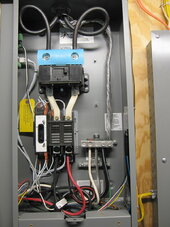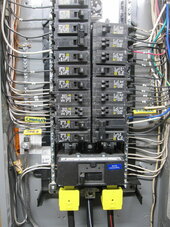So as a retired plumber I don't know how some of the intricacies of electrical pathways are separated. If you look in the sub panel, you can see that the ground and neutral bus bars are separate. However, in the switch box, the ground for the sub panel is on the neutral bar. So there is a path for the sub panel ground bus to the neutral bus in the main panel box. So instead of using the neutral from the auto transformer, I used a neutral from the sub panel into the inverter panel box, and if one side of the AT failed, it would try and complete the circuit by flowing back to the sub panel via neutral, that goes back to the switch box which has a ground for the sub panel. But it is a dead end to ground, isn't it? The grounds from the sub panel can get to neutral, but the neutral from the sub panel cannot get to ground because it goes back to the neutral bus. it's just a circular flow. since the neutral can't get to ground, nothing should get energized that shouldn't if the AT fails. But that is only one scenario, there may be more potential dangers I'm not aware of. But the bottom line, at least as I understood the issue is that the neutral from the sub panel box has no path to ground because in the main/switch box, the neutral and ground bus bars are separate. Sorry for being so long winded but I kind of half think it out as I write. Plus I'm a plumber so what do I know about electricity.

diysolarforum.com




